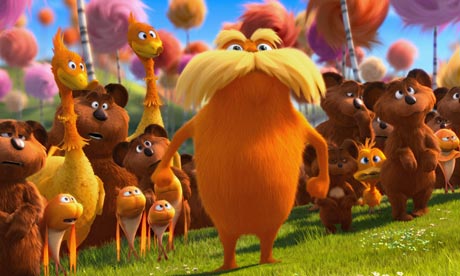
This week sees the release of The Lorax, Hollywood's latest attempt to haul the work of beloved children's author Dr Seuss up on to the big screen. At first glance The Lorax, one of Seuss's lesser-known children's stories, doesn't appear to be an obvious choice for a summer movie. It's a surprisingly bleak tale of the eponymous creature – a small, orange, moustachioed environmentalist – and his doomed attempt to "speak for the trees", and stop the forces of capitalism (as personified by the greedy Once-ler) from cutting down all the Truffulas in his native land. However, Hollywood – being Hollywood – has deftly circumnavigated all this doom and gloom by giving the film an unambiguously happy ending, and getting Zac Efron and Taylor Swift in to voice the main characters.
Seuss – real name Theodore Giesel – doesn't have an outstanding record when it comes to celluloid adaptations of his work. Apart from 1953's live-action Lynchian masterpiece, The 5,000 Fingers of Dr T, (which he wrote directly for the screen), there haven't been any truly successful films based on his writing. Those that exist range from the mildly diverting, such as 2000's Jim Carrey-starring How the Grinch Stole Christmas, to the downright diabolical The Cat in the Hat, which turned Mike Myers' career slide into a terminal plummet, and stands as one of the most egregious crimes ever committed in the name of "family entertainment".
The problem these adaptations all share is that they try to dispense with the very qualities that make Giesel's books so successful: the fantastically simple, infectious rhymes married to the brilliantly deadpan absurdity of his illustrations. The majority of Giesel's best-known children's books were written from an educational standpoint, the anapestic tetrameter employed to reinforce learning via phonics, and the limited vocabulary designed to encourage early readers. (Green Eggs and Ham, Giesel's most successful book, was the result of a $50 bet with his publisher that he couldn't write an entire book using fewer than 50 words. Giesel won.) But the poetic style of the books is almost always jettisoned by the films. They also tend, as with The Lorax, to muddy the simple moral message of the original work in favour of inserting unnecessary characters, pointless subplots, lame musical numbers and fist-gnawingly misguided jokes for the parents (something only Pixar has ever been able to pull off successfully).
Giesel once remarked that he never began writing with a message in mind: "Kids can see a moral coming a mile off and they gag at it." Which seems odd, as from a modern perspective he seems to have written some of the most overtly moral, if not downright politically subversive children's stories of the 20th century. The Sneetches, for example, concerns a race of slow-witted crane-like creatures who are segregated along apartheid lines into the superior "star-bellies" and inferior "plain-bellies". The plain-bellied Sneetches are then bamboozled by a visiting entrepreneur (going by the spectacular name of Sylvester McMonkey McBean) into parting with their cash in exchange for a trip through a contraption that will apply a star to their tums. In an effort to maintain their superiority, the original star-bellies are then persuaded to take a trip through McBean's "star-off" machine. Stars are continually removed and applied until the Sneetches are left penniless and McBean returns whence he came. Anyone who can read The Sneetches and not catch the faintest whiff of a moral message is probably paying less attention than a two-year-old on a sucrose high.
Giesel began his career working as a cartoonist for an advertising company, and during the war began submitting satirical sketches to newspapers. Just as you can see, in these early caricatures of Mussolini and Lindberg, the style that would eventually blossom into The Cat in the Hat, it's possible to view his later children's stories as thinly veiled commentary on the events of his day. Horton Hears a Who becomes a warning of the dangers of isolationism, How the Grinch Stole Christmas a critique of the commercialism of the holiday season, and Yertle the Turtle a satire of an autocratic dictator. In fact, in Giesel's original sketches, Yertle had a brush moustache, which he later dropped in order to avoid making the comparison too on the nose.
The fact that books like The Lorax are still selling in huge numbers today suggests that kids aren't gagging on the morals at all. The Dr Seuss stories get away with such sermonising for two reasons. First, they're funny, and second, they don't try too hard. Something that the adapters of his books could do well to bear in mind.

